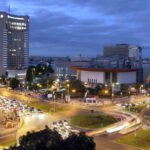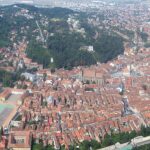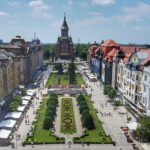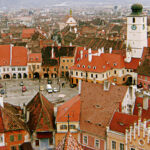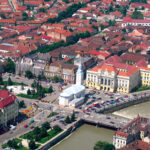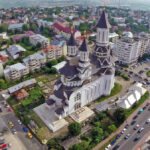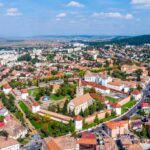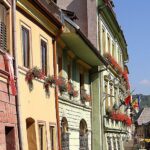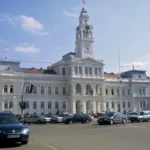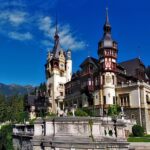Cluj-Napoca
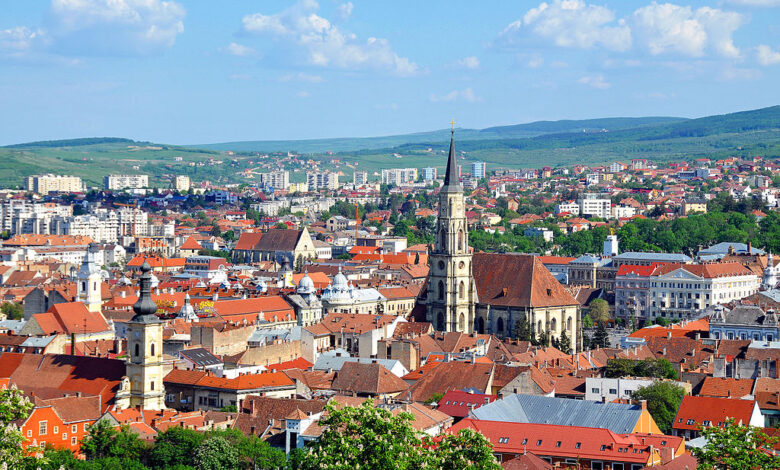
Cluj-Napoca (pronounced [ˈkluʒ naˈpoka]) is the second-most populous city in Romania and the seat of Cluj County in the northwestern part of the country. Geographically, it is roughly equidistant from Bucharest (445 kilometers (277 miles)), Budapest (461 km (286 mi)) and Belgrade (483 km (300 mi)). Located in the Someșul Mic river valley, the city is considered the unofficial capital of the historical province of Transylvania.
From its early roots to its current status as a bustling academic and technological hub, this Romanian gem has much to offer. Let’s embark on a journey through the cobblestone streets and explore the vibrant tapestry that is Cluj-Napoca.
Coordinates:  46°46′N 23°35′E 46°46′N 23°35′E | |
| Country | Romania |
|---|---|
| County | Cluj County |
| Status | County seat |
| Founded | 1213 (first official record as Clus) |
| Government | |
| • Mayor (2020–2024) | Emil Boc (PNL) |
| • Deputy Mayor | Dan Tarcea (PNL) |
| • Deputy Mayor | Emese Oláh (UDMR) |
| • City Manager | Gheorghe Șurubaru (PNL) |
| Area | |
| • City | 179.5 km2 (69.3 sq mi) |
| • Metro | 1,537.5 km2 (593.6 sq mi) |
| Elevation | 340 m (1,120 ft) |
| Population (2021) | |
| • City | 286,598 |
| • Density | 1,597/km2 (4,140/sq mi) |
| Time zone | UTC+2 (EET) |
| • Summer (DST) | UTC+3 (EEST) |
| Postal Code | 400xyz1 |
| Area code | +40 x642 |
| Car Plates | CJ3 |
| Website | primariaclujnapoca.ro |
Brief History
The history of Cluj-Napoca, formerly known as Napoca, spans various epochs. The Roman Empire conquered Dacia in AD 101-106, establishing the Roman settlement Napoca. In the Middle Ages, the city became part of the Kingdom of Hungary, and in 1316, it gained city status. The 16th-18th centuries saw religious shifts, with Protestant ideas emerging, and the city experiencing economic and cultural prosperity under Ottoman rule. In the 19th century, it became a center of the Hungarian national movement. After World War I, Cluj joined Romania.
The 20th century brought significant changes. In 1940, Cluj became part of Hungary, but in 1944, Romanian and Soviet troops captured it. The city was formally restored to Romania in 1947. The Hungarian Revolution of 1956 had an impact, and the demographic balance shifted over the years. During the Romanian Revolution of 1989, Cluj-Napoca witnessed unrest. After the fall of communism, nationalist sentiments influenced the city’s governance. Gheorghe Funar, known for strong Romanian nationalism, governed for 12 years until 2004. Subsequent years saw economic growth under Emil Boc’s leadership.
Economy
Cluj-Napoca is a significant economic hub in Romania, home to well-known local brands like Banca Transilvania, Terapia Ranbaxy, Farmec, Jolidon, and Ursus breweries. It has become a major center for software and IT activities, earning the nickname of Romania’s technopolis. Notably, the city attracted investments from Nokia, which established a mobile telephone factory and a research center. The former Nokia factory was later acquired by De’Longhi. Cluj-Napoca hosts headquarters of various national and international companies, including MOL, Aegon, Emerson, De’Longhi, Bechtel, FrieslandCampina, and Bosch.
The city is a regional commercial center with numerous street malls and hypermarkets. Key avenues like Eroilor, Napoca, Memorandumului, Regele Ferdinand, and 21 Decembrie 1989 feature high rental costs. Major malls, such as VIVO! and Iulius Mall, house hypermarkets like Carrefour and Auchan. International hypermarket chains like Cora, Metro, Selgros, as well as DIY stores like Baumax and Praktiker, are also present.
Cluj-Napoca’s shopping centers feature a variety of international retailers, including H&M, Zara, Guess, Camaïeu, Bigotti, Orsay, Jolidon, Kenvelo, Triumph, Tommy Hilfiger, Sephora, Yves Rocher, Swarovski, Ecco, Bata, Adidas, Converse, and Nike.
In 2021, the city’s general budget reached 2.117 billion lei (over 433 million Euros), marking a significant increase from the 2008 level. In terms of tourism, the county offered a total of 6,472 beds in 2007, with a substantial number of visitors, including foreigners mainly from Hungary, Italy, Germany, the United States, France, and Austria. The city’s numerous travel agencies assist in organizing domestic and foreign trips, and car rentals are readily available.
Transport
Cluj-Napoca boasts a comprehensive regional transportation system, encompassing road, air, and rail connections to major cities in Romania and Europe. The city features an extensive public transportation network, including bus, trolleybus, and tram lines.
Road: Cluj-Napoca is a vital node in the European road network, situated on three European routes (E60, E81, E576) and connected to major national roads (DN1, DN1C, DN1F). The ongoing construction of the A3 Transylvania Motorway will link the city to Bucharest and the western border. The Cluj-Napoca Coach Station facilitates coach connections to various locations across the country.
The city has approximately 175,000 licensed automobiles, and the Cluj County ranks sixth nationally in cars sold. The road infrastructure supports a significant number of taxis.
Air: The Cluj-Napoca International Airport (CLJ) is the second busiest in Romania, serving over 1.4 million passengers in 2015. It offers direct international flights across Europe. The airport is connected to the city center by public transport (bus and trolley). A modern control tower is set to be inaugurated in 2016.
Rail: The Cluj-Napoca Rail Station is part of the CFR-Romanian Railways Main Line, providing direct connections to major Romanian cities and Budapest. The rail station is well-integrated with the city’s public transport system, including trams, trolleybuses, and buses. Secondary rail stations and a cargo station further enhance rail connectivity.
Public Transport: The local public transport company, CTP, operates an extensive network covering 321 kilometers within the city, including tram, trolleybus, and bus routes. Private bus companies contribute to transportation in the Cluj-Napoca metropolitan area, connecting to neighboring towns and villages.
Trams: CTP manages a tram line in the city, with planned modernization involving new rail tracks, separation from road traffic, and route alterations to enhance efficiency and speed.
Metro: Studies for a proposed Cluj-Napoca Metro began in late 2018, with design and execution works awarded in February 2023 for Line I to the Gülermak – Alstom Transport – Arcada Company. The metro system aims to further enhance the city’s transportation infrastructure.
Culture
Cluj-Napoca is a vibrant and multicultural city with a rich history and culture. The city is home to a number of universities, museums, and theaters. It is also a popular destination for tourists, who come to see its many historical landmarks and to enjoy its lively nightlife.
A. Rich cultural heritage
The city proudly boasts a rich cultural heritage, shaped by influences from Roman, Hungarian, and Saxon civilizations. This diversity is evident in the local customs, traditions, and celebrations that make Cluj-Napoca a captivating mosaic of cultures.
B. Influences from various civilizations
Cluj-Napoca’s streets are a living testament to the interplay of various civilizations. From medieval churches to Baroque-style buildings, the architectural landscape reflects the city’s dynamic past.
Places of interest
Some of the most popular places of interest in Cluj-Napoca include:
- The Cathedral of the Dormition of the Theotokos
- The Church of St. Michael
- The Matthias Corvinus Statue
- The Bánffy Palace
- The Cluj-Napoca Botanical Garden
- The Central Park
- The National Museum of Transylvanian History
- The Ethnographic Museum of Transylvania
- The Art Museum of Cluj-Napoca
Geography of Cluj-Napoca
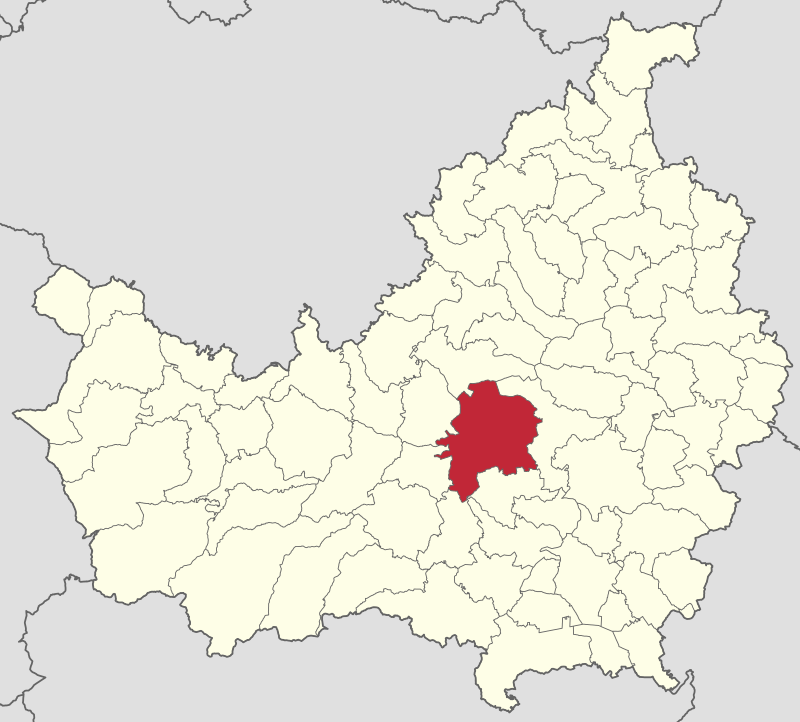
Cluj-Napoca, situated in Transylvania, covers 179.5 square kilometers and lies at the convergence of the Apuseni Mountains, Someș plateau, and Transylvanian plain. The city spans valleys, hills, and rivers, surrounded by peaks ranging from 500 to 700 meters. Notable areas include Feleac Hill, Dealurile Clujului, and the Botanical Garden. Various parks, including Central Park, Iuliu Hațieganu Park, Hașdeu Park, Cetățuia, and Opera Park, contribute to the city’s greenery.
The surroundings boast botanical reservations with rare plant species, and nearby forests host diverse wildlife. The Hoia-Baciu forest is known for reported alien encounters. Ski resorts on Feleac Hill and Băișoara cater to winter sports enthusiasts, while Cojocna and Someșeni Baths offer summer relaxation. The countryside features numerous castles, with Bonțida Bánffy Castle being notable. Nicula Monastery, a pilgrimage site, houses the wonder-working Madonna of Nicula.
Cluj-Napoca experiences a warm-summer continental climate, influenced by the Apuseni Mountains. Winter temperatures rarely fall below −10 °C, with snow covering the ground for 65 days. Summers see an average temperature of 18 °C, though occasional highs of 35-40 °C occur. The city has the EU’s best air quality, according to a 2014 study.
Education
Cluj-Napoca has a rich history of higher education, anchored by Babeș-Bolyai University (UBB), the largest in Romania, hosting around 50,000 students in various specializations taught in Romanian, Hungarian, German, and English. Established in 1872 as the University of Cluj, it went through several relocations during historical shifts, finally merging with a Hungarian university in 1959.
The city is home to nine other universities, including the Technical University, Iuliu Hațieganu University of Medicine and Pharmacy, University of Agricultural Sciences and Veterinary Medicine of Cluj-Napoca (USAMV), University of Arts and Design, Gheorghe Dima Music Academy, and private educational institutions.
Public education in Cluj-Napoca dates back to 1409, with a Catholic school established in the 14th century. Presently, the city hosts nearly 150 pre-university educational institutions, supervised by the County Board for Education. These include 62 kindergartens, 30 primary schools, and 45 high schools. While most schools use Romanian as the primary language of instruction, there are Hungarian-language schools and mixed-language schools with Romanian/German or Romanian/Hungarian classes.
In the 1993–94 school year, 18,208 students were enrolled in secondary schools, with an additional 7,660 attending professional schools. Primary and pre-school education included 37,111 pupils and 9,711 children, respectively.
